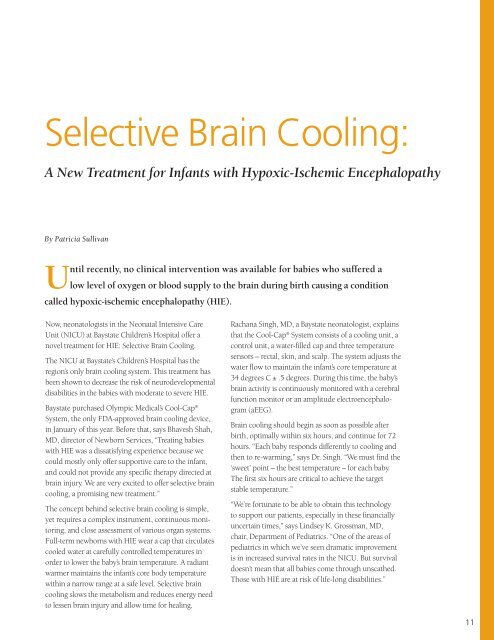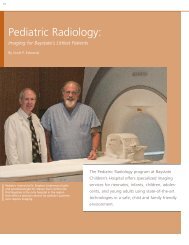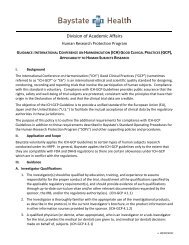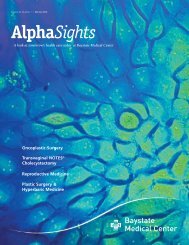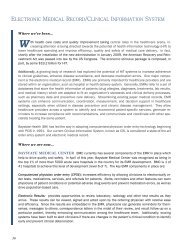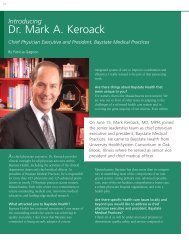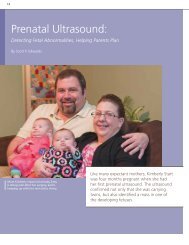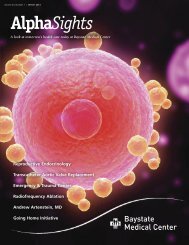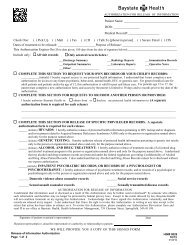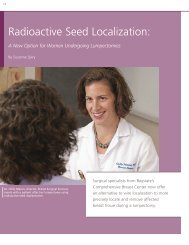Read it in pdf format - Baystate Health
Read it in pdf format - Baystate Health
Read it in pdf format - Baystate Health
You also want an ePaper? Increase the reach of your titles
YUMPU automatically turns print PDFs into web optimized ePapers that Google loves.
Selective Bra<strong>in</strong> Cool<strong>in</strong>g:<br />
A New Treatment for Infants w<strong>it</strong>h Hypoxic-Ischemic Encephalopathy<br />
By Patricia Sullivan<br />
Until recently, no cl<strong>in</strong>ical <strong>in</strong>tervention was available for babies who suffered a<br />
low level of oxygen or blood supply to the bra<strong>in</strong> dur<strong>in</strong>g birth caus<strong>in</strong>g a cond<strong>it</strong>ion<br />
called hypoxic-ischemic encephalopathy (HIE).<br />
Now, neonatologists <strong>in</strong> the Neonatal Intensive Care<br />
Un<strong>it</strong> (NICU) at <strong>Baystate</strong> Children’s Hosp<strong>it</strong>al offer a<br />
novel treatment for HIE: Selective Bra<strong>in</strong> Cool<strong>in</strong>g.<br />
The NICU at <strong>Baystate</strong>’s Children’s Hosp<strong>it</strong>al has the<br />
region’s only bra<strong>in</strong> cool<strong>in</strong>g system. This treatment has<br />
been shown to decrease the risk of neurodevelopmental<br />
disabil<strong>it</strong>ies <strong>in</strong> the babies w<strong>it</strong>h moderate to severe HIE.<br />
<strong>Baystate</strong> purchased Olympic Medical’s Cool-Cap ®<br />
System, the only FDA-approved bra<strong>in</strong> cool<strong>in</strong>g device,<br />
<strong>in</strong> January of this year. Before that, says Bhavesh Shah,<br />
MD, director of Newborn Services, “Treat<strong>in</strong>g babies<br />
w<strong>it</strong>h HIE was a dissatisfy<strong>in</strong>g experience because we<br />
could mostly only offer supportive care to the <strong>in</strong>fant,<br />
and could not provide any specific therapy directed at<br />
bra<strong>in</strong> <strong>in</strong>jury. We are very exc<strong>it</strong>ed to offer selective bra<strong>in</strong><br />
cool<strong>in</strong>g, a promis<strong>in</strong>g new treatment.”<br />
The concept beh<strong>in</strong>d selective bra<strong>in</strong> cool<strong>in</strong>g is simple,<br />
yet requires a complex <strong>in</strong>strument, cont<strong>in</strong>uous mon<strong>it</strong>or<strong>in</strong>g,<br />
and close assessment of various organ systems.<br />
Full-term newborns w<strong>it</strong>h HIE wear a cap that circulates<br />
cooled water at carefully controlled temperatures <strong>in</strong><br />
order to lower the baby’s bra<strong>in</strong> temperature. A radiant<br />
warmer ma<strong>in</strong>ta<strong>in</strong>s the <strong>in</strong>fant’s core body temperature<br />
w<strong>it</strong>h<strong>in</strong> a narrow range at a safe level. Selective bra<strong>in</strong><br />
cool<strong>in</strong>g slows the metabolism and reduces energy need<br />
to lessen bra<strong>in</strong> <strong>in</strong>jury and allow time for heal<strong>in</strong>g.<br />
Rachana S<strong>in</strong>gh, MD, a <strong>Baystate</strong> neonatologist, expla<strong>in</strong>s<br />
that the Cool-Cap ® System consists of a cool<strong>in</strong>g un<strong>it</strong>, a<br />
control un<strong>it</strong>, a water-filled cap and three temperature<br />
sensors – rectal, sk<strong>in</strong>, and scalp. The system adjusts the<br />
water flow to ma<strong>in</strong>ta<strong>in</strong> the <strong>in</strong>fant’s core temperature at<br />
34 degrees C ± .5 degrees. Dur<strong>in</strong>g this time, the baby’s<br />
bra<strong>in</strong> activ<strong>it</strong>y is cont<strong>in</strong>uously mon<strong>it</strong>ored w<strong>it</strong>h a cerebral<br />
function mon<strong>it</strong>or or an ampl<strong>it</strong>ude electroencephalogram<br />
(aEEG).<br />
Bra<strong>in</strong> cool<strong>in</strong>g should beg<strong>in</strong> as soon as possible after<br />
birth, optimally w<strong>it</strong>h<strong>in</strong> six hours, and cont<strong>in</strong>ue for 72<br />
hours. “Each baby responds differently to cool<strong>in</strong>g and<br />
then to re-warm<strong>in</strong>g,” says Dr. S<strong>in</strong>gh. “We must f<strong>in</strong>d the<br />
‘sweet’ po<strong>in</strong>t – the best temperature – for each baby.<br />
The first six hours are cr<strong>it</strong>ical to achieve the target<br />
stable temperature.”<br />
“We’re fortunate to be able to obta<strong>in</strong> this technology<br />
to support our patients, especially <strong>in</strong> these f<strong>in</strong>ancially<br />
uncerta<strong>in</strong> times,” says L<strong>in</strong>dsey K. Grossman, MD,<br />
chair, Department of Pediatrics. “One of the areas of<br />
pediatrics <strong>in</strong> which we’ve seen dramatic improvement<br />
is <strong>in</strong> <strong>in</strong>creased survival rates <strong>in</strong> the NICU. But survival<br />
doesn’t mean that all babies come through unscathed.<br />
Those w<strong>it</strong>h HIE are at risk of life-long disabil<strong>it</strong>ies.”<br />
11


